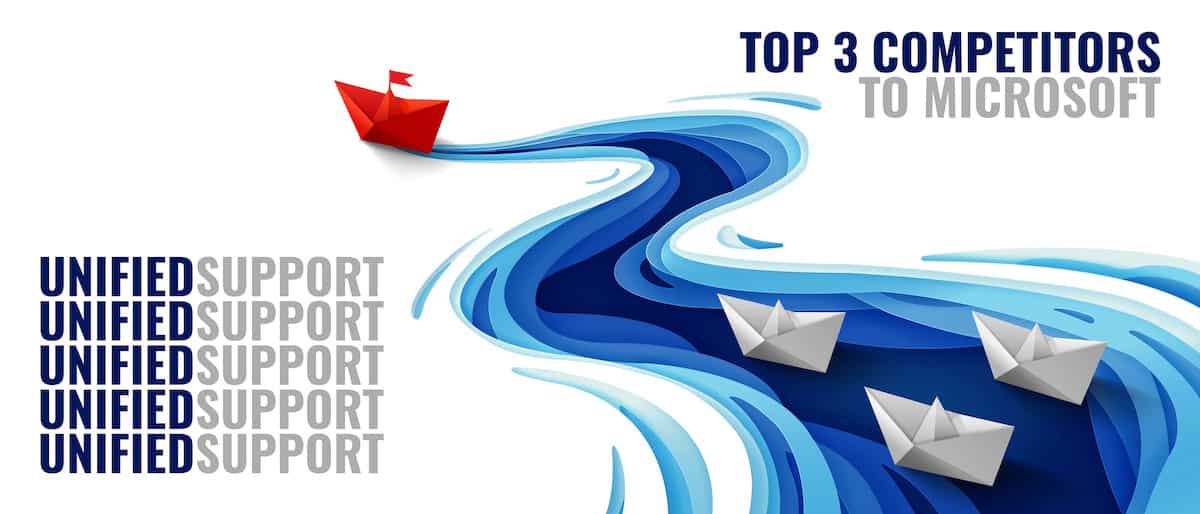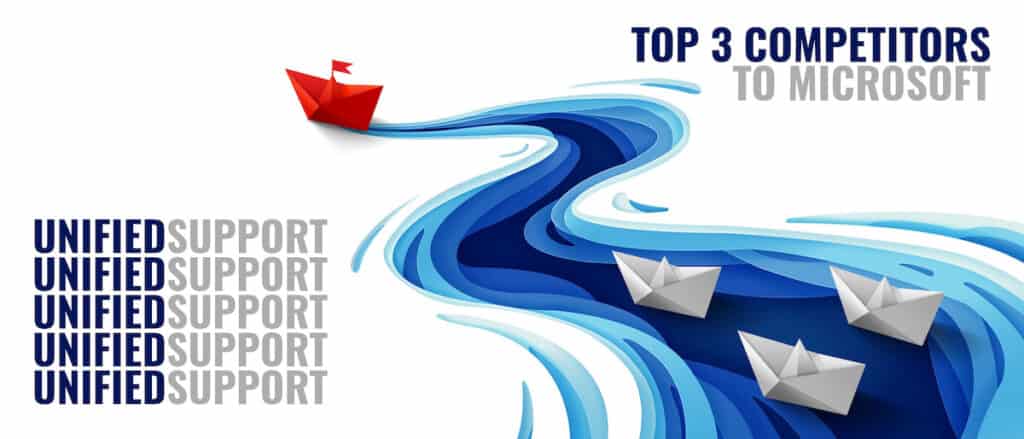

Who Are Microsoft Unified Support’s Biggest Competitors.
Microsoft Unified Support - Top 3 Competitors
IT analyst firms have identified 3 Microsoft Unified Support competitors.
Enterprises should understand why they compete with MS Unified. Of the 3, who is the biggest Unified competitor and when does it makes sense to replace Microsoft Support with a third-party.
Audience: Microsoft Vendor Management | IT Sourcing & Procurement | CIO

Why Compete with Microsoft Unified Support
Why would anyone choose to compete with the largest software company in the world? There are two primary drivers: cost and quality.
Unified Support Cost
Many Microsoft Gold Certified Partners have heard for years that Microsoft Premier Support was expensive but at least their customers could buy the number of hours they actually needed. The new “as needed” Unified Support model is a significant overall price increase for most organizations. Up to 50% or more according to Gartner’s latest 2022 report. And the news spread quickly through the Microsoft Partner community. And while some partners were afraid to bite the hand that feeds them, some boldly chose to step off the Microsoft licensing gravy train and do what’s best for the client. Deliver Microsoft support at a reasonable cost and compete with the OEM software support offering.
Unified Support Quality
As Microsoft’s focus shifted away from small enterprises in 2018 towards mid-market and large enterprise targets for more impactful cloud licensing deals, Premier Support quality began to wane for Microsoft’s small enterprise customers. With the formal rollout of Unified Support in 2020 and its unlimited support ticket model, additional load began to build on the service delivery teams. With the retirement of Premier Support in June 2022, Unified is now the only support option offered by Microsoft. As a result, mid-size enterprises are now bearing the brunt of the falling support quality with missed response targets, languishing tickets, non-compliant offshore support, and loss of their TAM.
How Many Competitors to Unified Are There
According to Gartner’s latest Market Guide for Independent Third-Party Support, dated September 12, 2022, there are 3 competitors to Microsoft Unified Support.
Competitor #1 to Unified supports Microsoft (database only), Oracle, SAP, and IBM.
Competitor #2 to Unified supports Microsoft (database only), Oracle, and SAP.
Competitor #3 to Unified supports Microsoft (all products).
Read Gartner Report G00757595 for full details.
Who is the Biggest Competitor to MS Unified
Per the world’s largest IT analyst and research firms¹, US Cloud is the biggest Microsoft Unified competitor with service delivery capability to fully replace Unified.
Additional datapoints for US Cloud as Microsoft’s primary competitor:
- Supports clients in 28 countries worldwide with 24/7 follow-the-sun teams.
- Industries supported include information technology, government, higher education, computer software, banking, hospital & healthcare, financial services, oil & energy, manufacturing, insurance, and utilities.
- Year over year growth² and focus on Microsoft enterprise support since 2017.
- Software integration with enterprise ITSM ITIL certified platforms. ISO 27001 certified.
- Over 600 enterprise customers including Fortune 500 and Global 2000.
- All US domestic workforce screened for security and compliance.
- Certified diversity supplier meeting enterprise and Federal contract diversity mandates.
¹ Gartner, IDC, Infotech
² Inc 5000 List 2020, 2021
When to Choose a Competitor Over Microsoft
For many organizations there are one or more scenarios where it makes sense for them to move from MS Unified to a third-party.
Financial or budget pressure
An increasing number of organizations believe they are not receiving a fair value in return for their Microsoft support fees. For years, big software vendors have enjoyed a virtual monopoly on support services for their products. With more than 90% profit margin on support operations, you pay a vendor 10 dollars for every dollar the vendor spends on actual support.
Licensees are coming to the conclusion that the software vendor support model is at best dated — and at worst obsolete and seemingly unfair.
Third-party Microsoft support lets you cut IT costs immediately and gain a predictable, low-cost support model for the future. Today, highly responsive third-party IT support is available at an immediate annual cost savings compared to original vendor support fees, sometimes by as much as 50%. And that’s just the tip of the iceberg.
Longer resolution time or IT frustration
While Microsoft Premier and Unified support costs have continued to rise, the level of customer service provided seems to have steadily declined. When you contact Microsoft about a problem, a junior-level technican might advise you to upgrade or implement a service pack that combines hundreds of other fixes. The technician may also suggest that it is a custom code issue and is therefore your problem. Before you know it, one small issue has morphed into a big project with regression testing and downtime that costs a lot of money and consumes time and other resources. When you get back in touch with support, it is difficult to get access to experienced engineers unless you navigate a maze of offshored escalations.
Third-party Microsoft support takes a fundamentally different approach, typically emphasizing full service over self-service. In place of a help-desk generalist taking your call, you may speak to a highly experienced support engineer who can directly address your issues, with no escalations.
As clients experience responsive support, they come to rely on and truly leverage their third-party Microsoft support program. Organizations that historically logged only five or six issues a year with their vendor may suddenly call third-party support 10 or 15 times a month. Why? The most frequent response is, “You actually fix our issues!” Cases that had been logged with software vendors for years but never addressed, including some of the toughest and most complex issues, are frequently resolved in days or weeks.
Forced upgrade or migration
Although product upgrades 10 or 15 years ago delivered vital new features to automate core business processes, that’s not usually the case now. Today’s proven software applications are highly functional and reliably support tens of thousands of organizations and billions of dollars in transactions.
Extending the life of a current release through third-party support reduces risks and costs. New Microsoft software releases can take months or years to fully vet and debug, disrupting the previously stable production environment. Likewise, the constant deployment of software vendor fixes introduces its own set of risks.
And while software vendors have invested in developing cloud versions of their apps and acquired companies to meet those goals, their licensees seem less enthusiastic about the functionality and migration costs of these options. Today’s trends include investments in hybrid IT — innovating around core systems with best-of-breed applications that enhance the customer experience, improve employee relations, and drive commerce.
By delaying or avoiding costly and disruptive Microsoft product upgrades, you’ll have more capacity to invest in strategic initiatives that may improve your company’s bottom line today.
Already use third-party support for Oracle or SAP
Today, third-party IT support has been embraced by world-class organizations of all sizes. Over 60% of the Fortune 500 currently use a third-party support provider for Oracle, SAP, or IBM. These enterprises know the model works and are already reaping the benefits of cost savings and better service. Adding Microsoft to the list is a natural progression.
In addition, prominent industry analysts and members of the media have recently recognized the role of third-party Microsoft support in a comprehensive IT strategy. US Cloud, for example, has experienced significant and sustained growth since the company launched in 2017. Organizations worldwide, including midmarket, public sector, and Fortune 500 companies have made the switch to US Cloud.
Microsoft enterprise software licensees have made the move to US Cloud because we offer an alternative that has delivered immediate ROI. And yes, our clients can and do continue to work with Microsoft to purchase additional licenses. Our response time SLA is 15 minutes or less for all severities, with actual response time of less than seven minutes on average. You’ll find smart, fanatical support engineers at US Cloud. These experienced professionals are committed to a single, vital goal: to provide the finest Microsoft enterprise support to IT teams.
